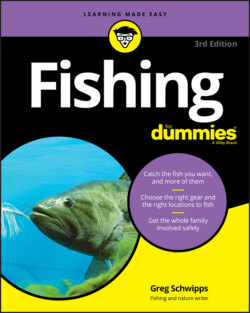Читать книгу Fishing For Dummies - Greg Schwipps - Страница 76
How to fish the water
ОглавлениеIn places like marshes or brackish streams, a high tide offers gamefish a chance to chase baitfish and other prey in prime habitat. But a low tide will force fish back into deeper water, so time your trips to coincide with moving tides. Falling tides are often as good or better than rising ones. Gamefish will often be following the tide, chasing the displaced bait. Fish inside harbor, bay, and creek mouths during high tides, as fish will be moving into shallow water, and outside bay mouths (downtide) as the tide recedes (see Figure 3-1).
All tides can consolidate and move fish. Look for ambush points like rock outcroppings that gamefish use (just as freshwater fish do) to catch prey being carried by the tide. Look for variances in structure — reefs, sandbars, and drop-offs — and watch for signs of fleeing baitfish. Birds won’t help you so much in most freshwater fishing situations, but in saltwater, they’re a valuable aid. Watch birds such as terns and particularly seagulls — they’ll respond to schools of baitfish, and if the birds are following the bait, you can be sure the gamefish are, as well. Sightfishing is often better in saltwater, too, as you can often spot fish like bonefish, tarpon, stripers, bluefin, bluefish, seatrout (specks), and redfish when they come into shallow water to feed. Polarized sunglasses, which are recommended in Chapter 6, will help you see the fish.
© John Wiley & Sons, Inc.
FIGURE 3-1: Fish staging outside a marsh during a falling tide.
